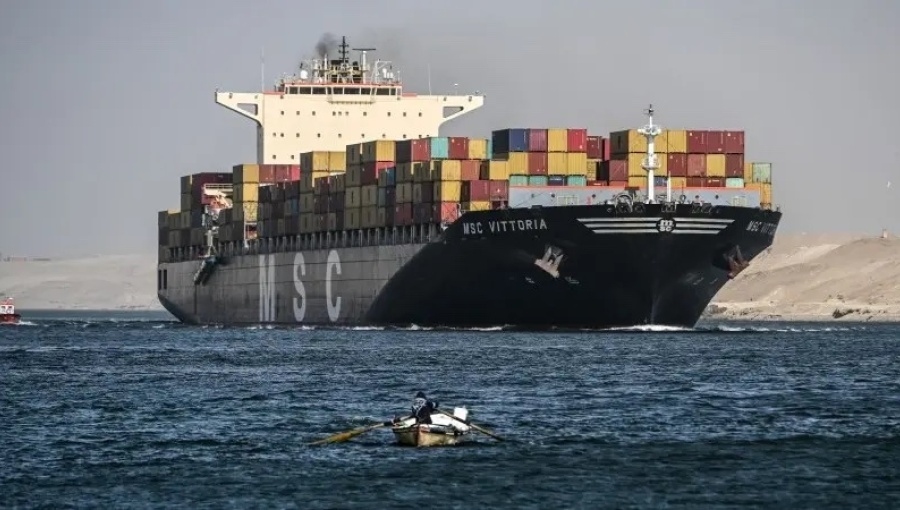India–US Trade Tensions Rise Over Steel and Auto Tariffs NMDC Limited reports a 38% drop in Q4 FY24 consolidated net profit RINL to Raise $23 Million Through Land Sales Amid Crisis

The Red Sea issue, fueled by attacks on commercial vessels by Iranian-backed Houthis, is changing global trade paths and posing enormous difficulties to commodity markets. There is a boom in maritime traffic across Southern Africa due to shipowners' reluctance to take the traditional Suez Canal route, which has led to concerns about increasing costs and supply interruptions.
The increasing stress in commodities markets presents supply vulnerabilities, particularly in the energy markets. However, there hasn't yet been a significant impact on the supply of LNG and oil. Customers and refiners may initially have constraints while supply chains adapt to the lengthier path. Given the uncertainty and spillover risk, oil prices will probably be well sustained for the foreseeable future. More escalation and a significant reduction in the oil supply are required to see oil prices break much higher.
Global oil flows
The Red Sea crisis substantially affects global oil flows because the region is the transit point for about 12% of all seaborne oil traffic worldwide. In the first half of 2023, 9.2 million b/d passed through the Suez Canal and SUMED pipeline, while 8.8 million b/d crossed the Bab el-Mandeb Strait. Due to the EU's prohibition on Russian oil imports, the conflict between Russia and Ukraine caused oil flows to be shifted southward into Asia. Middle distillate flows increased from 490k b/d in 2021 to 860k b/d in 2023 as they travelled across the Red Sea from the Middle East and Asia to reach Europe.
As a result of rising tensions and bombings in Yemen, an increasing number of ships are bypassing the Red Sea and instead taking the Cape of Good Hope route. Although this causes tanker traffic to detour and lengthens the voyage, refiners are first impacted by tightening oil supply chains. To reduce risk, importers—particularly India, which depends on Russian oil—might consider diversifying, which could increase the discount on Urals.
Despite increased tanker diversions, the current scenario does not limit oil supply or movement. The larger risk is that the problem could spread, causing interruptions in the Strait of Hormuz, through which over 20 million b/d flows —20% of global consumption. The fact that only Saudi Arabia and the United Arab Emirates have pipeline capacity to bypass the Strait highlights how serious the situation is for the world's economy and oil market. Escalation in this region is a major worldwide worry as the Red Sea strikes compel ships to cross the Cape of Good Hope, leaving the Strait of Hormuz as the only route for Persian Gulf oil shipments.
The Red Sea has become increasingly important for LNG flows
The Red Sea has emerged as an essential conduit for global LNG traffic, accounting for around 8% of the total. An increase in US LNG export capacity uses this route to send more supplies to Asia, particularly in light of the Panama Canal's limitations from dry weather. Europe is particularly susceptible to changes in the LNG market because of its heavy reliance on LNG due to the suspension of Russian pipeline gas. In 2023, approximately 20 billion cubic metres of LNG were shipped to Europe by Qatar, the most significant Middle Eastern provider, accounting for 16% of all LNG imports into Europe. While the Red Sea currently avoids attacks, carrier avoidance is rising, with US and Qatari LNG rerouting intentions. Any decline might result in short-term difficulties, including rerouting Qatari LNG to Asia and US LNG to Europe, avoiding the Red Sea and the more challenging South Africa route. Notably, delays in the Strait of Hormuz represent a considerable danger to Qatari LNG flows since Qatar accounts for 20% of worldwide LNG supply, shipping an anticipated 108 bcm in 2023.
Tensions increase metal shipping times and costs
Metal shipping is severely impacted by the Red Sea conflict, especially for containerised items, which presents an upside risk for the sector. Approximately 80% of container ships travelling the Suez route have been forced to reroute; by the first week of January, that number has risen to 90%. Notable shipping companies, including MSC, Maersk, Hapag Lloyd, Cosco, ONE, Evergreen, HMM, and ZIM, have been forced to detour their vessels to avoid the Cape. Due to this rerouting, container prices have tripled, and delivery periods have been extended by weeks. Consequently, higher freight expenses will be reflected in the final metals price.
Aluminium, a key metal affected, has shown optimistic price patterns, particularly for premiums over the LME price. After declining for several months, primary aluminium premiums in Rotterdam have increased by 10% to 15% since December. These prices are supported by the shipping disruption, especially in the crucial Middle East region. The shipping disruptions worsen the difficulties because Europe mostly depends on aluminium imports, and local output is at its lowest point in a century. Reduced production since December 2021, which makes up 2% of the world's total, combined with rising energy prices following Russia's invasion of Ukraine, has a special effect on metals that require a lot of energy, such as aluminium. Incentives to transport material to Europe have decreased due to low premiums in recent months, leaving the market with few buffer stocks to prepare for unexpected demand spikes in the upcoming months.
The Red Sea crisis is a complicated geopolitical problem that will significantly impact the world's commodity markets. As tensions rise and trade channels evolve, stakeholders from many industries must carefully monitor events to manage risks and adapt to the changing landscape.
Also Read : India's prolonged reliance on fossil fuels: Dissecting the nuanced truths Red Sea disruption: Indian refineries redirect diesel cargo to Asia as Europe loading dip